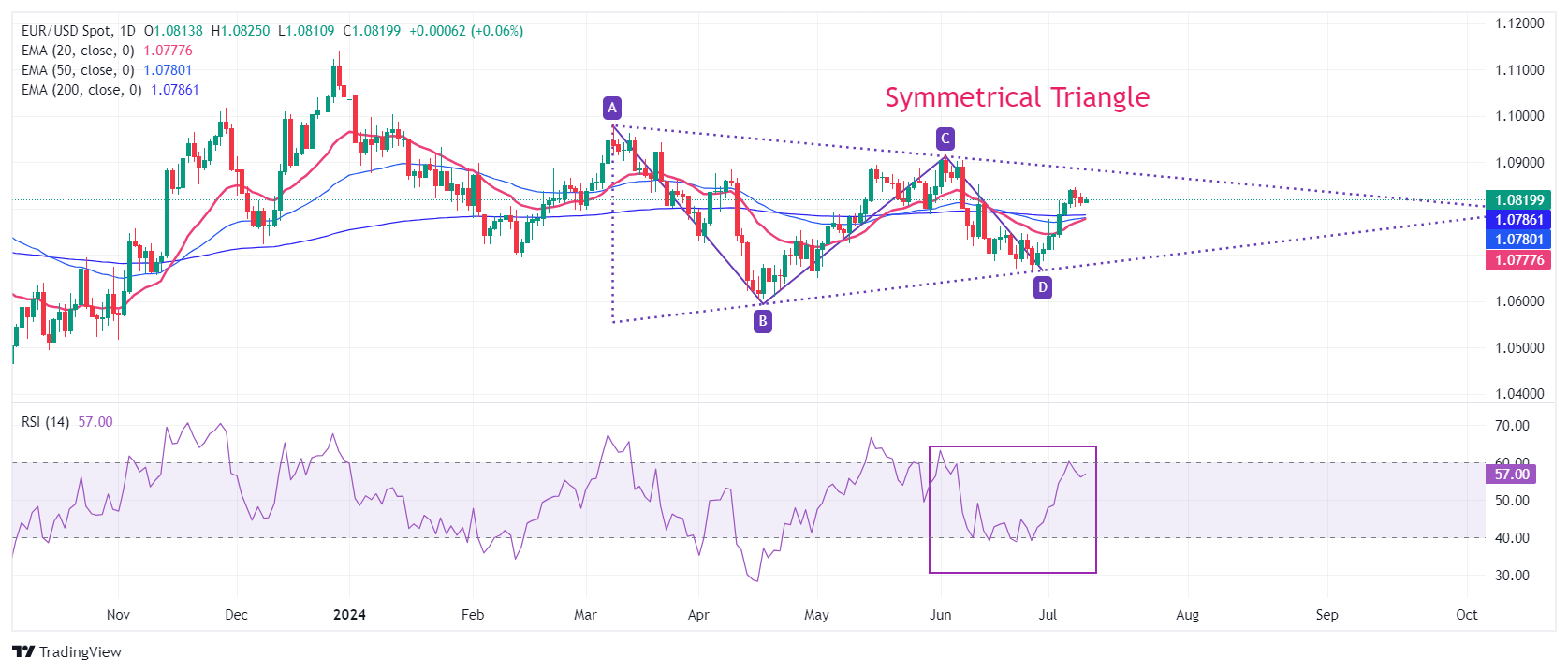- EUR/USD holds gains in a narrow range above 1.0800 on multiple tailwinds.
- Powell’s caution on US labor market puts the US dollar at a disadvantage.
- Euro gains ground as far-right defeat reduces upside risks of French financial crisis.
EUR/USD is trading sideways around 1.0800 in the European session on Wednesday after a modest corrective move from a near four-week high of 1.0850. The major currency pair remains sidelined as investors await the United States (US) Consumer Price Index (CPI) data for June, due out on Thursday.
Economists expect core inflation, which excludes volatile food and energy items, to have grown steadily by 0.2% and 3.4% on a monthly and annual basis, respectively, in June. Annual headline inflation is estimated to have slowed to 3.1% from May’s reading of 3.3%, while the monthly figure is expected to have grown by 0.1% after remaining unchanged earlier.
Inflation data will provide clues as to whether current expectations that the Federal Reserve will begin cutting interest rates starting at its September meeting are appropriate.
Meanwhile, Fed Chairman Jerome Powell signaled in remarks at semiannual testimony before Congress on Tuesday that rate cuts are not appropriate until policymakers gain significant confidence that inflation is on track to return to the desired 2% rate.
However, Powell warned of declining U.S. economic strength as the labor market loses momentum. Powell said, “Labor market conditions have cooled considerably compared with two years ago,” adding that the U.S. “is no longer an overheated economy.”
Daily Market Movers Roundup: EUR/USD Gains as ECB Rate Cut Bets Ease
- EUR/USD holds onto gains above 1.0800, inspired by a weak US Dollar (USD) and a decent recovery in the Euro as Marine Le Pen-led far-right party, the National Rally, fails to secure an outright majority in the French election. The US Dollar Index (DXY), which tracks the value of the Greenback against six major currencies, faces pressure to extend the recovery above 105.20.
- The far right fails to secure an absolute majority despite leading in the first round, resulting in easing fears of a French financial crisis. However, uncertainty over fiscal adjustments and the distribution of ministries remains high as the economy will be run by a coalition government. Economists expect French President Emmanuel Macron’s centrist alliance to unite with the left, also known as the New Popular Front, led by Jean-Luc Mélenchon.
- Meanwhile, diminishing expectations of subsequent rate cuts by the European Central Bank (ECB) keep the Euro in a favourable position. ECB policymakers continue to refrain from committing to a predefined rate-cutting path, fearing that an aggressive expansionary stance could reverse the disinflation process.
- On Tuesday, ECB governing council member and Bank of Italy Governor Fabio Panetta said the central bank could gradually cut interest rates without any pause to curb inflationary pressures. Panetta added that past policy tightening continues to weigh on demand, output and inflation.
Technical Analysis: EUR/USD holds above 1.0800
EUR/USD is trading in a tight range slightly above the round-level support of 1.0800 as investors remain on the sidelines ahead of the US CPI report for June. The major currency pair is stabilizing above the 20-day and 50-day exponential moving averages (EMAs), which are trading around 1.0750 and 1.0770, respectively. The overall trend of the shared currency pair has also strengthened as it has broken above the 200-day EMA, which is trading around 1.0800.
A Symmetrical Triangle formation on the daily time frame exhibits a strong contraction in volatility, indicating low volume and narrow ticks.
The 14-day Relative Strength Index (RSI) reaches 60.00. Will bullish momentum be triggered if it breaks above 60.00?
Euro FAQs
The Euro is the currency of the 20 European Union countries that belong to the Eurozone. It is the second most traded currency in the world, behind the US Dollar. In 2022, it accounted for 31% of all foreign exchange transactions, with an average daily volume of over $2.2 trillion per day. EUR/USD is the most traded currency pair in the world, accounting for an estimated 30% of all transactions, followed by EUR/JPY (4%), EUR/GBP (3%) and EUR/AUD (2%).
The European Central Bank (ECB), based in Frankfurt, Germany, is the reserve bank of the Eurozone. The ECB sets interest rates and manages monetary policy. The ECB’s main mandate is to maintain price stability, which means controlling inflation or stimulating growth. Its main instrument is to raise or lower interest rates. Relatively high interest rates – or the expectation of higher rates – generally benefit the Euro and vice versa. The Governing Council of the ECB takes monetary policy decisions at meetings held eight times a year. Decisions are taken by the heads of the national banks of the Eurozone and six permanent members, including ECB President Christine Lagarde.
Eurozone inflation data, as measured by the Harmonised Index of Consumer Prices (HICP), is an important econometric data point for the euro. If inflation rises more than expected, especially if it exceeds the ECB’s 2% target, the ECB is forced to raise interest rates to bring inflation back under control. Relatively high interest rates compared to their peers usually benefit the euro, as it makes the region more attractive as a place for global investors to park their money.
Data releases measure the health of the economy and can influence the Euro. Indicators such as GDP, manufacturing and services PMIs, employment and consumer sentiment surveys can influence the direction of the single currency. A strong economy is good for the Euro. Not only does it attract more foreign investment, but it can encourage the ECB to raise interest rates, which will directly strengthen the Euro. Conversely, if economic data is weak, the Euro is likely to fall. Economic data from the four largest Eurozone economies (Germany, France, Italy and Spain) are especially significant, as they account for 75% of the Eurozone economy.
Another important output for the euro is the trade balance. This indicator measures the difference between what a country earns from its exports and what it spends on imports during a given period. If a country produces highly sought-after export products, its currency will appreciate due to the additional demand created by foreign buyers who wish to purchase these goods. Therefore, a positive net trade balance strengthens a currency and vice versa for a negative balance.
Source: Fx Street
I am Joshua Winder, a senior-level journalist and editor at World Stock Market. I specialize in covering news related to the stock market and economic trends. With more than 8 years of experience in this field, I have become an expert in financial reporting.








